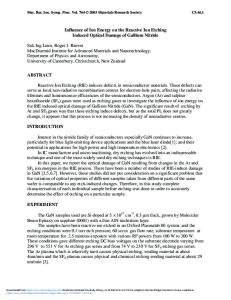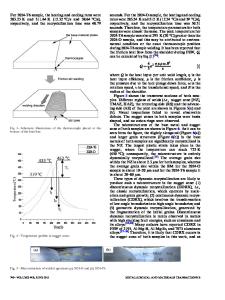The effect of ion induced damage on the hardness, wear, and friction of zirconia
- PDF / 1,177,989 Bytes
- 7 Pages / 593.28 x 841.68 pts Page_size
- 74 Downloads / 265 Views
W. Hertl Corning Inc., Corning, New York 14831
T. L. Alford, P. B0rgesen, and J.W. Mayer Department of Materials Science and Engineering, Cornell University, Ithaca, New York 14853 (Received 15 June 1989; accepted 9 October 1989)
Microhardness measurements were carried out on ion implanted single crystal Y2O3 stabilized cubic ZrO2. Inert gas ions (Ne, Ar, Xe) and N, Si, Ti, and W were implanted up to fluences of 3 x 1017 ions/cm2. Implantation energies were selected to give equivalent ranges. Comparison of the Knoop microhardness values of ZrO2 implanted with various species over a range of fluences showed that the principal variable causing hardness changes is damage energy and not the ion fluence nor the ion species. For all implants studied, the hardness versus damage energy gives a unified plot. At low doses the hardness rises with increasing deposited damage energy to a value 15% higher than that of unimplanted zirconia. With additional damage the hardness drops to a value 15% lower than that of the unimplanted zirconia. Friction and wear measurements in a pin-on-disk assembly showed very different behavior for high dose versus unimplanted ZrO2. The unimplanted samples showed debris with an associated rise in friction. The implanted system showed much less debris and a constant value of friction even after 10000 cycles.
I. INTRODUCTION
Extensive studies have been reported on the effects of ion implantation and ion mixing of deposited layers into metals. In contrast, relatively few studies have been carried out with ceramic materials.1"3 Kelly4 has reviewed the effects of implantation into ceramics prior to 1981, including phase changes in halides, oxides, carbides, and borides. A recent review by McHargue2 gives a thorough overview of recent work on mechanical properties of ion implanted ceramics. In general, ceramic samples made amorphous by implantation exhibit reduced hardness, but increased resistance to crack propagation. Lower dose implants or annealing of higher dose implants results in a modified, but crystalline structure characterized by high residual compressive stresses, increased hardness, and resistance to crack propagation. Amorphization occurs when the defect concentration exceeds a critical value.5 Implantations at liquid nitrogen temperatures are more likely to cause amorphization by freezing in defects. When implanted at higher temperatures (e.g., room temperature) the surface is generally not amorphized, presumably due to dynamic annealing.6 This gives a surface region which is not completely disordered,7 but may have a high density of point defect clusters.8 J. Mater. Res., Vol. 5, No. 2, Feb 1990
http://journals.cambridge.org
Downloaded: 18 Mar 2015
The most detailed ceramic studies have been carried out on A12O3. A variety of ions have been implanted such as Fe,8 Zr,9 Cr, Ti,10 Ar, Y,11 and N.12 These studies cover strengthening, hardness, friction, annealing in reducing and oxidizing atmospheres, impurity and damage distributions, amorphization, and radiation enhanced diffusion.
Data Loading...











